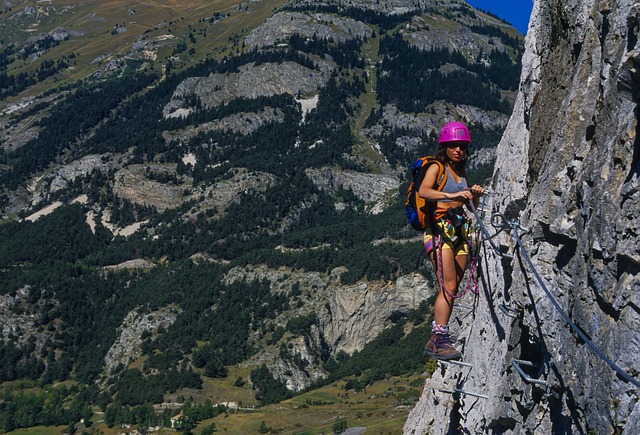Since World War One, people have been using metal cableways to safely cross steep and exposed mountainsides. Today, via ferrata is becoming more and more popular as a adventure and tourism activity.
So what is via ferrata all about?
It's hard to precisely define via ferrata. Basically, this activity is much safer than vertical rock climbing but more technical than a simple scramble.
In this article I'll go through everything you need to know, and have, before taking on via ferrata routes.
What is Via Ferrata? - Your Questions Answered
What does Via Ferrata Mean?
Via Ferrata in English means ‘Iron Way’. It is a type of climbing route that involves using a steel cable, rungs, metal ladders, and other fixed anchors to help climbers navigate steep or exposed terrain.
How Did Via Ferrata Start?
Via ferrata was first developed in the Italian Dolomites during World War I. It was a way of allowing soldiers to move quickly and safely through the mountainous terrain.
The routes were equipped with ladders, ropes, and other aids to facilitate troop movement and supplies. With them, the soldiers could move through the mountains with greater ease and speed.
After the war, the via ferrata routes were adapted for civilian use. Many have been restored and since become popular with outdoor enthusiasts. Today, these cableways can be found in many mountainous areas around the world, including Europe, North and South America, and Asia.
What Is Via Ferrata Rock Climbing?
When people talk about Via Ferrata they are referring to wearing a harness and carabiner set and clipping on to the cable system which has been previously installed on rocks. You can think of it as something between rock scrambling and real rock climbing.
The routes can be a stand alone course. More commonly these are more technical sections of longer hiking or mountain climbing trails. Many via ferrata routes are optional detours. It is a way to experience the thrill of climbing in a safe and controlled environment.
Do You Need To Be Experienced To Use Via Ferrata Routes?
While prior climbing experience can certainly be helpful, it is not always necessary. Many routes are designed with beginners in mind and can be completed by people with little to no climbing experience. All you need is a basic level of fitness and to be comfortable with heights.
Before attempting this type of climbing, it is recommended that you familiarize yourself with the basics of climbing and receive proper instruction on how to use the equipment and navigate the route.
Always choose a course that is appropriate for your skill level and physical abilities. If you are uncertain, it is always better to err on the side of caution. To start with, I recommend taking a guided tour or going with an experienced partner who can assist you in the event of an emergency.
What Happens If You Fall While Using Via Ferrata?
If you fall while attached to a via ferrata, you should remain attached to the cable by your lanyard. These are designed to absorb the shock and prevent you from falling far. Your climbing partner or instructor should be able to help you regain your footing.
It is important to note that falling can still be dangerous. There is potential for serious injuries, particularly if you hit a rock or other obstacle on the way down. That is why it is important to always wear proper climbing gear, including a helmet.
What Equipment Do You Need For Via Ferrata?
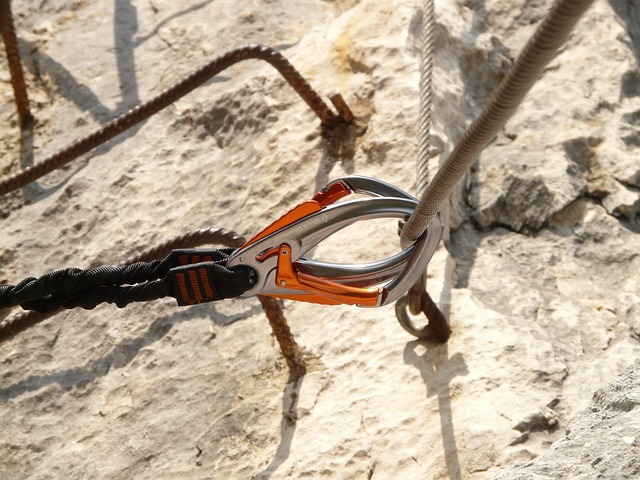
To safely complete a via ferrata route, you will need specialized equipment designed for climbing. The following are the essentials in a via ferrata set:
Helmet
A helmet is essential for protecting your head in case of a fall or from falling rocks or debris. It should fit snugly and have a chin strap to keep it in place.
Via Ferrata Harness
A harness is designed to distribute the weight and force of a fall evenly across your body. It usually has a waist belt and leg loops that are adjustable for a comfortable fit.
Via Ferrata Lanyard
The lanyard connects your harness to the steel cable that runs along the route. It is made of elastic webbing and has two carabiners at each end. One of which is a special carabiner with a locking mechanism that prevents it from coming off the cable accidentally.
Carabiners
These are metal hooks that close with a special lock system. They attach the end of the Lanyard to the metal cable on a via ferrata system.
Via ferrata sets use two carabiners on the end of the cord. This is because there are some routes where you need to unhook from one section and latch onto the next. Having a double carabiner system means you always stay safely attached on at least one point, even when changing to another line.
Where Do I Get Via Ferrata Gear?
On most European hiking routes where there are via ferratas, you can rent this equipment from mountain huts or stores in nearby towns. Renting is the best option if you are a beginner or only occasionally need the gear. If you do this activity more regularly, you might want to buy your own via ferrata set.
It is essential to check that it is quality equipment that can hold your weight and is in good condition. Make sure you receive proper instructions on how to use the equipment.
Top Regions To Try Via Ferrata
The European Alps have over 1000 via ferrata routes scattered along mountain trails and peaks. Italy, Switzerland and France have the majority. Today, many countries across the globe are catching on to this trend.
These are Best Regions For Via Ferrata.
Dolomites, Italy
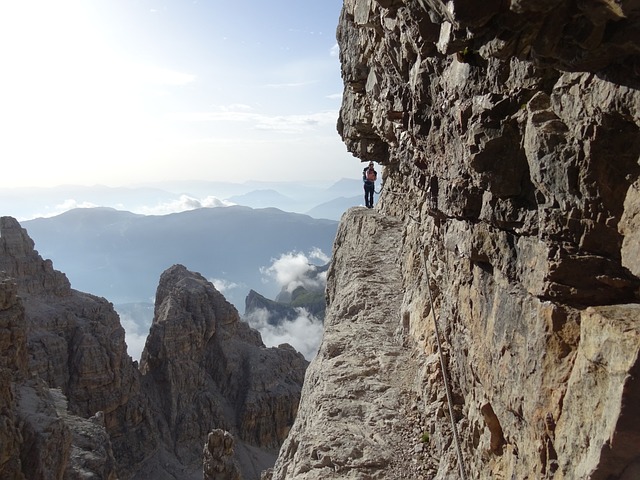
Via ferrata in Brenta, Italy
The Dolomites in Italy are where via ferrata originated, as such the region is home to some of the oldest via ferrata routes. The longest section of via ferrata in the Dolomites is 7km. Some famous trails like Alta Via 1 have optional sections of cableways that take you through World War 1 tunnels.
Switzerland
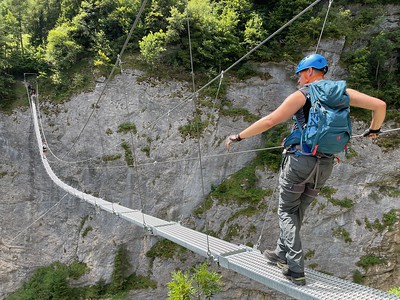
A hair raising suspension bridge on the Murren via ferrata (photo by: Andy Harbach)
There are many Via Ferrata Routes In Switzerland including the adventurous Murren Via Ferrata in The Jungfrau region of the Swiss Alps. Another well-known and challenging route takes climbers up Eiger Mountain
French Alps
There are more than 200 options for via ferrata in France. The 1600m Les Bettieres route is well known with three different sections increasing in difficulty. It is a great choice for people with different experience levels.
Tyrol, Austria
Tyrol is a region in western Austria that is known for its beautiful mountain scenery and wide range of via ferrata routes. Some routes are suitable for families with children.
Julian Alps, Slovenia
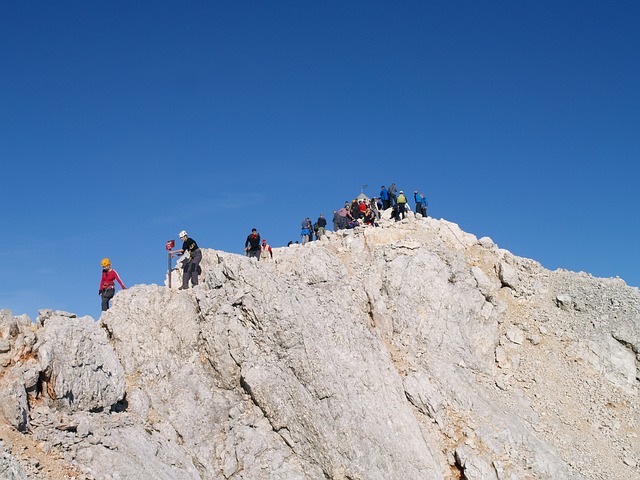
Climbing Mount Triglav
The Julian Alps in Slovenia offers a variety of light climbing routes. These take you through beautiful gorges and over stunning mountain peaks. If you climb Mount Triglav, most routes use via ferrata on the final ascent.
Spain
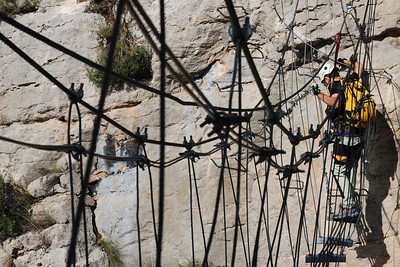
Via ferrata in Spain (Photo by Monitotxi)
Recreational via ferrata routes were only established in Spain in the 1990s. The activity quickly grew in popularity and today there are over 300 via ferratas in the Pyrenees and other parts of the country. Most of these routes can be climbed year round.
Canadian Rockies, Canada
The Canadian Rockies offer some spectacular via ferrata routes. The Banff Via Ferrata at Mount Norquay, Banff National Park is one of the most famous. Mount Nimbus via ferrata is the highest via ferrata in Canada.
Telluride, Colorado, USA
Telluride is home to the highest via ferrata in the United States, with a route that takes you across a 300-foot-long suspension bridge and up a steep rock face with stunning views of the San Juan Mountains.
Via Ferrata - More FAQs
What is the highest via ferrata in the world?
Asia's Mount Torq on Mount Kinabalu rock face is the world’s highest via ferrata. It starts at 3,200m and end at 3,776m above sea level.
What Is The Most Difficult Via Ferrata In The World?
It’s hard to say which route is most difficult. The Extraplomix in Gran Canaria (canary islands) is definitely amongst the top 10. This is very technical route graded as extremely difficult.
What Is The Easiest Via Ferrata In The World?
Via Ferrata Gran Cir, in the Italian Dolomites, is regularly listed as one of the easiest for beginners. It’s not very technical and the route has low exposure.
What Age Is Via Ferrata For?
Anyone in good physical condition can attempt this activity. Most routers are safe enough for children as young as 6/7. If you are booking a tour, age limits depend on the operator.
What is The Maximum Weight For Via Ferrata?
Most harnesses and gear can support up to either 50, 100 or 120kg (264lbs). This is including any gear and backpacks.

